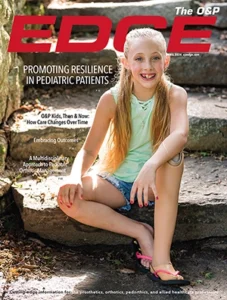Researchers at Columbia University’s Fu Foundation School of Engineering and Applied Science designed a spinal orthosis that measures the three-dimensional stiffness of the human torso, which they believe could lead to new treatments for children with idiopathic scoliosis and kyphosis. The Robotic Spine Exoskeleton (RoSE) is a dynamic brace that enabled the team to conduct the first study that looks at in vivo measurements of torso stiffness and characterizes the three-dimensional stiffness of the human torso. The study was published online March 30 in IEEE Transactions of Neural Systems and Rehabilitation Engineering.

The RoSE consists of two six-DOF parallel-actuated modules connected in series, each with six actuated limbs. Each module controls the translations/rotations or forces/moments of one ring in three dimensions with respect to the adjacent ring.
Photograph courtesy of Sunil Agrawal/Columbia Engineering.
“The RoSE is the first device to measure and modulate the position or forces in all six degrees of freedom [DOF] in specific regions of the torso,” said the study’s principal investigator Sunil Agrawal, PhD, professor of mechanical engineering at Columbia Engineering and professor of rehabilitation and regenerative medicine at Columbia University Vagelos College of Physicians and Surgeons. “This study is foundational and we believe will lead to exciting advances both in characterizing and treating spine deformities.”
Developed in Agrawal’s Robotics and Rehabilitation Laboratory, the RoSE consists of three rings placed on the pelvis, mid-thoracic, and upper-thoracic regions of the spine. The motion of two adjacent rings is controlled by a six-DOF parallel-actuated robot. Overall, the system has 12 DOF controlled by 12 motors. The RoSE can control the motion of the upper rings with respect to the pelvis ring or apply controlled forces on these rings during the motion. The system can also apply corrective forces in specific directions while still allowing free motion in other directions.
Eight healthy male subjects and two male subjects with spine deformities participated in the pilot study, which was designed to characterize the three-dimensional stiffness of their torsos. The researchers used the RoSE to control the position/orientation of specific cross sections of the subjects’ torsos while simultaneously measuring the exerted forces/moments. The results showed that the three-dimensional stiffness of the human torso can be characterized using the RoSE and that the spine deformities induce torso stiffness characteristics that are significantly different from the healthy subjects. Because abnormal spinal curves are three-dimensional, the stiffness characteristics are curve-specific and depend on the locations of the curve apex on the human torso, according to the study’s authors.
“We built upon the principles used in conventional spine braces, i.e., to provide three-point loading at the curve apex using the three rings to snugly fit on the human torso,” said lead author Joon-Hyuk Park, PhD. “In order to characterize the three-dimensional stiffness of the human torso, the RoSE applies six unidirectional displacements in each DOF of the human torso, at two different levels, while simultaneously measuring the forces and moments.”
While this first study used a male brace designed for adults, Agrawal and his team have designed a brace for girls with idiopathic scoliosis and is actively recruiting girls with scoliosis to characterize how torso stiffness varies due to the medical condition.
“Directional difference in the stiffness of the spine may help predict which children can potentially benefit from bracing and avoid surgery,” said Agrawal.
Editor’s note: This story was adapted from materials provided by Columbia University.




